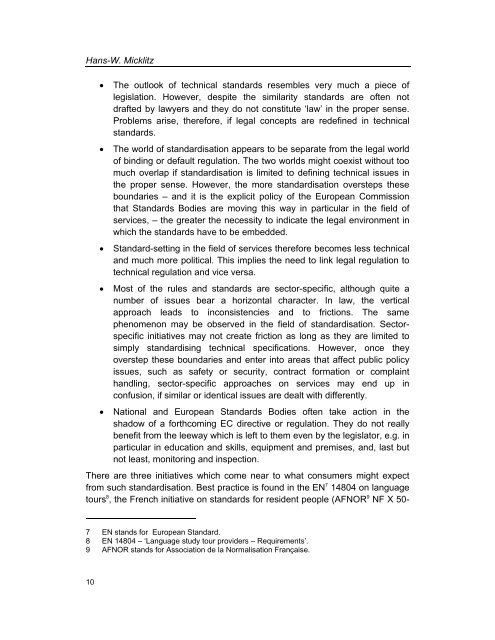Services Standards: Defining the Core Consumer Elements ... - ANEC
Services Standards: Defining the Core Consumer Elements ... - ANEC
Services Standards: Defining the Core Consumer Elements ... - ANEC
Create successful ePaper yourself
Turn your PDF publications into a flip-book with our unique Google optimized e-Paper software.
Hans-W. Micklitz<br />
• The outlook of technical standards resembles very much a piece of<br />
legislation. However, despite <strong>the</strong> similarity standards are often not<br />
drafted by lawyers and <strong>the</strong>y do not constitute ‘law’ in <strong>the</strong> proper sense.<br />
Problems arise, <strong>the</strong>refore, if legal concepts are redefined in technical<br />
standards.<br />
• The world of standardisation appears to be separate from <strong>the</strong> legal world<br />
of binding or default regulation. The two worlds might coexist without too<br />
much overlap if standardisation is limited to defining technical issues in<br />
<strong>the</strong> proper sense. However, <strong>the</strong> more standardisation oversteps <strong>the</strong>se<br />
boundaries – and it is <strong>the</strong> explicit policy of <strong>the</strong> European Commission<br />
that <strong>Standards</strong> Bodies are moving this way in particular in <strong>the</strong> field of<br />
services, – <strong>the</strong> greater <strong>the</strong> necessity to indicate <strong>the</strong> legal environment in<br />
which <strong>the</strong> standards have to be embedded.<br />
• Standard-setting in <strong>the</strong> field of services <strong>the</strong>refore becomes less technical<br />
and much more political. This implies <strong>the</strong> need to link legal regulation to<br />
technical regulation and vice versa.<br />
• Most of <strong>the</strong> rules and standards are sector-specific, although quite a<br />
number of issues bear a horizontal character. In law, <strong>the</strong> vertical<br />
approach leads to inconsistencies and to frictions. The same<br />
phenomenon may be observed in <strong>the</strong> field of standardisation. Sectorspecific<br />
initiatives may not create friction as long as <strong>the</strong>y are limited to<br />
simply standardising technical specifications. However, once <strong>the</strong>y<br />
overstep <strong>the</strong>se boundaries and enter into areas that affect public policy<br />
issues, such as safety or security, contract formation or complaint<br />
handling, sector-specific approaches on services may end up in<br />
confusion, if similar or identical issues are dealt with differently.<br />
• National and European <strong>Standards</strong> Bodies often take action in <strong>the</strong><br />
shadow of a forthcoming EC directive or regulation. They do not really<br />
benefit from <strong>the</strong> leeway which is left to <strong>the</strong>m even by <strong>the</strong> legislator, e.g. in<br />
particular in education and skills, equipment and premises, and, last but<br />
not least, monitoring and inspection.<br />
There are three initiatives which come near to what consumers might expect<br />
from such standardisation. Best practice is found in <strong>the</strong> EN 7 14804 on language<br />
tours 8 , <strong>the</strong> French initiative on standards for resident people (AFNOR 9 NF X 50-<br />
7 EN stands for European Standard.<br />
8 EN 14804 – ‘Language study tour providers – Requirements’.<br />
9 AFNOR stands for Association de la Normalisation Française.<br />
10
















